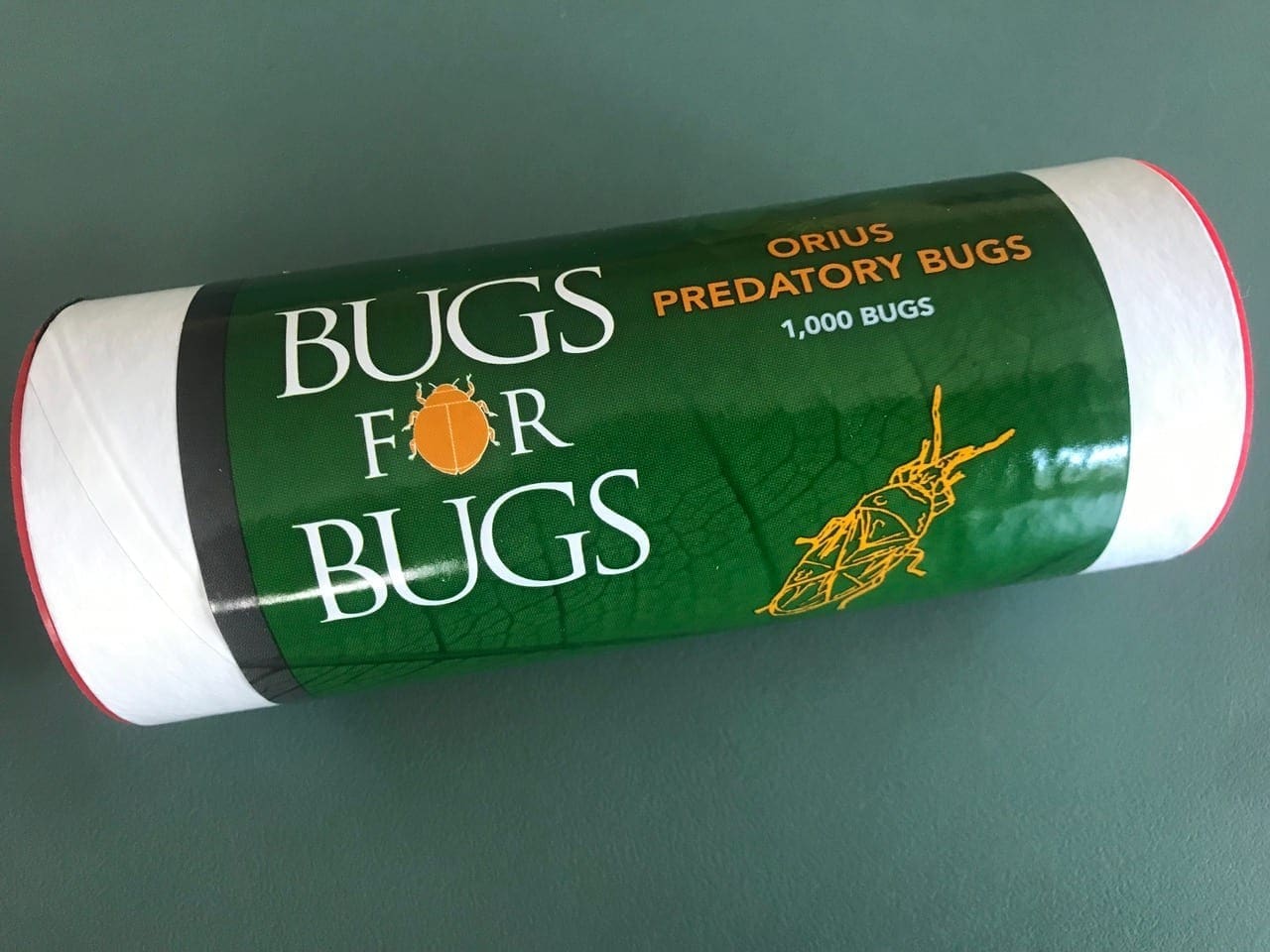Description
Orius (Orius tantillus) are predatory bugs that feed on thrips. Unlike many other thrips predators, Orius are able to feed on adults as well as immatures. If thrips numbers are low, they can survive on alternate prey such as aphids, mites, whitefly and moth eggs. They use their syringe-like mouthparts to impale their prey and then suck out the body contents. Orius also feed on pollen, which is an essential part of their diet.
Orius eggs are laid directly into plant tissue. They pass through several nymph stages before developing wings and becoming adults. Both nymphs and adults are able to feed on thrips but adults are more aggressive, killing more prey than they require for sustenance. Adults are highly mobile and fly through the crop in search of food. They develop from egg to adult in 2-4 weeks (depending on temperature) and adults live for a further 3-4 weeks.
Download our Orius technical information sheet here
Target pests
- Thrips (including western flower thrips)
Advantages
- Orius kill more prey than they require for sustenance
- The adults kill up to 20 thrips per day and live for 3-4 weeks
- Adult and juvenile Orius feed on all stages of thrips, including the adults
- They feed on a range of other pests including aphids, mites, whiteflies and moth eggs
- Orius are suitable for preventative release in pollen-bearing crops and crops containing flowering banker plants
Suitable crop environments
Orius are well suited to crops where pollen is naturally abundant (e.g. capsicums, eggplant, strawberries and raspberries). In crops that do not produce adequate pollen (e.g. cucumbers) or crops in which flowers are harvested before opening (e.g. roses) it is necessary to use pollen- bearing banker plants such as basil.
Release rates
Unlike chemicals, when it comes to beneficials, more is always better. However, they are costly to produce and our goal is to achieve the best results at minimal expense. There are many factors to consider, including the value of the crop, the severity of the pest outbreak and the activity (or otherwise) of naturally occurring beneficial species.As a general rule, 2-3 releases of modest numbers is better than a single large release. This reduces risk, improves establishment and accelerates the development of multiple overlapping generations. In most cases our releases are inoculative and we anticipate that our beneficials will establish and breed up within the crop to give long term control.
Release rates will vary depending on the crop and level of infestation. The table below is only a guide – contact us for specific recommendations.
| Situation | Rate (per release) | No. of releases | Release interval |
| Preventative | 2-3 bugs/m2 | 2-3 | 1-2 weeks |
| Curative | 5-10 bugs/m2 | 2-3 | 1 week |
When to release
Orius should be released preventatively as soon as there is pollen present (in the crop or banker plants) to support them. Orius should be used as part of a comprehensive IPM program. Complementary thrips biocontrol agents include Montdorensis, Cucumeris and Hypoaspis predatory mites.
How to release
Before release, check prior history of chemical applications to ensure toxic residues are no longer present. See notes on chemical use below.
Orius are supplied in cardboard tubes containing at least 1,000 adult bugs. They are mixed with buckwheat hulls to improve distribution. Sterilised moth eggs are included as a food source, and a segment of green bean is also included to provide additional moisture and a site for Orius to lay eggs during transit.
Release as soon as possible after delivery, preferably during the cooler hours of morning or late afternoon/early evening. If necessary, tubes can be stored (on their side) for up to 2 days at 10-15°C.
Roll the tube gently to distribute the predators evenly within and then sprinkle the medium over the heads of the plants (close to flowers). It is best if the medium remains on the leaves, however adult Orius are capable of flight and they will find their way into the crop if they fall to the ground during release. The bean will contain freshly laid Orius eggs, so it should be placed within the crop at the time of release.
After release
Continued survival and efficacy will depend on availability of food (both prey and pollen) as well as environmental conditions (e.g. temperature, humidity and especially chemical residues). After release, adults live for several weeks and begin feeding on thrips and other pests immediately. However, it takes a few weeks to observe evidence of population establishment (nymphs and adults) within the crop.Monitor Orius by tapping flowers to check for nymphs and adults. Use yellow and blue sticky traps to detect and monitor activity of adult thrips. Use ThriPher pheromone lures to improve western flower thrip trap capture.
Top-up releases may be required in high pressure situations or if Orius numbers drop due to unavoidable use of harmful pesticides.
Cultural practices to aid establishment
Creating a habitat with high plant diversity (including flowering species) can greatly improve the survival and population development of Orius. In outdoor crops this may be achieved through strip or border plantings of flowering species suited to your local growing conditions. In greenhouse crops basil banker plants have proven a highly effective tool to aid Orius establishment and improve thrips control.
Flowering basil banker plants provide pollen for Orius to feed on and an ideal environment in which they can breed. It is most important to use bankers in crops that do not produce adequate pollen for Orius. They can also be a helpful tool in pollen bearing crops because they allow Orius (and other beneficials) to establish before pests arrive. Basil bankers also act as a trap crop because the white scented flowers are highly attractive to thrips.
Sow banker plants early so they are flowering by the time the main crop is planted. For short crops (e.g. cucumbers) grow them in pots so they can be moved from one crop to the next. For longer crops (e.g. roses) plant them in the growing medium of the main crop. Use about 200 banker plants per ha. Place them throughout the crop at planting and inoculate them with Orius as soon as they begin to flower.
Chemical use
Orius are very effective predators but they are sensitive to many pesticides. Harmful pesticides may be directly toxic or have sublethal effects. They can prevent Orius from establishing and/or reduce their efficacy. Some insecticides (e.g. synthetic pyrethroids, organophosphates and neonicotinoids) can have residual toxicity that affects Orius for months.
If pesticides are required, always check for side-effects and select products that are least harmful to Orius and other key beneficials in your IPM program. Consult the Biobest side-effects manual online or via the app.






stuart.sb (verified owner) –
I had a serious thrip issue, and was terrified of the consequences. Orius saved the day! It annihilated all visible thrips. I did see a resurgence which I realised may have been to do with some thrips hiding in slits in newly growing leaves on my nepenthes, or the pupae in the soil. Adding nematodes that eat them to the soil, and trimming off new leaves where they could have been hiding, seems to be enough to allow the orius to eradicate the rest. Hypoaspis might be a good one to try for the pupae in the soil as well but I have not tried it.